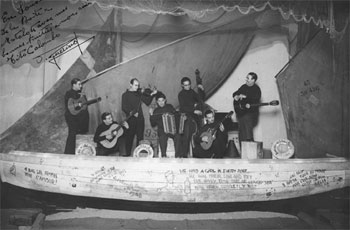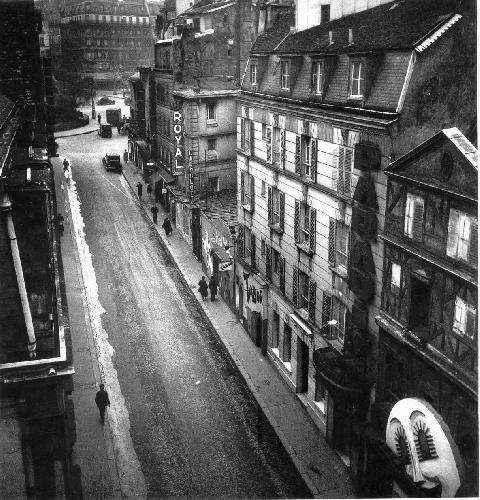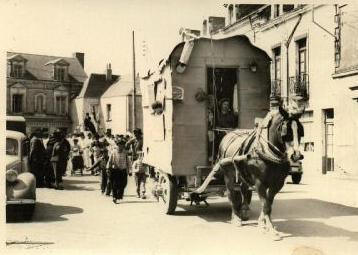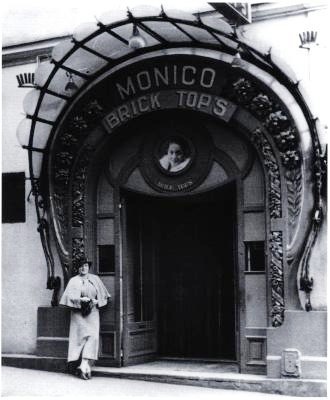Django’s Haunts
Many Jazz Historians feel that were it not for Paris’s wholehearted welcome of Jazz & Afro-American Jazz Musicians, the Music might never have fully developed and found its place in the world. From 1914 through the 1930s, the Hot Spot for Jazz in Paris was old Montmartre, a section of the City in which many Afro-American Jazz Musicians lived, and the Site of many Legendary Jazz Clubs, including Le Grand Duc and Bricktop’s. Decades later, the now ritzy Streets just off of the Champs-Elysees were the place to go. Today, Jazz can be found all over the City, from huge Public Venues to small cosy settings, to a single Musician blowing Jazz Standards on his Sax on (or under) a Bridge.
La Java 1924
Cafe Des Lion. Nice 1931
Le Boite a Matelots 1932 – The Sailors Dive a copy of the Palm Beach Club in Cannes. Parisian cabaret founded in April 1932 at 10 rue Fontaine. Vola got a gig with his band in Boîte á Matelots in Pigalle Paris, opened by Léon Volterre and he directed the orchestra to entertain the guests in the famous Claridge Hotel at its Thé Dansants; he played the accordion in the 14-Men Tango-orchestra.
Salle Lafayette 1934
Balajo Rue de Lappe
A cobbled Street in the 11th arrondissement of Paris, in the Bastille neighbourhood and best known for its nightlife. In the 20thC rue de Lappe started picking up a reputation as a centre of Paris Nightlife. By the 1930s 17 Dance Halls were installed in the Street one of which the Balajo (9 rue de Lappe, 75011 Paris) still exists. The Balajo played host to many legendary entertainers of the day such as Edith Piaf & Django Reinhardt.
Chez Florence Paris 1934
Florence Jones was the 1st African-American woman to rule the Paris Jazz world in the 1920s. She preceded both Ada “Bricktop” Smith & Josephine Baker in that regard. Her fame was built less on her singing & dancing than on her ability to amuse & captivate the crowds at the Clubs where she held sway. First at Eugene Bullard’s, Le Grand Duc, and later at Louis Mitchells Club across the Rue Pigale, Florence kept the late crowd dancing throughout the night. Mitchell soon renamed his Club, Chez Florence, in her honour. She was known for snubbing all but the most illustrious of Guests and making her victims love her all the more for it. “Ivory-white, lipstick-red, and a suave, tawny brown are the colours of Florence Jones. These were colours good enough for smart, expatriate Americans of both hemispheres who discovered “Florence” making excellent waffles in the Rue Pigale. Her waffles became a fad, and so many rich waffle eaters washed the golden morsels down with amber Champagne that, today, Florence Jones the more purseful than many of her Clients. The fact that this handsome Negress, genuinely from Harlem, keeps the smartest “boite de nuit* in Paris, Habituéés, such as the Princess Murat, & Sem, famed Cartoonist, were unsurprised. What if the 3rd son of George V had come in? They recalled how once the King-Emperor’s eldest son, on a memorable visit to Chez Florence, called across to her: “Hey, Florence! How many Poules do you know in Montmartre?” Replied Florence: “Poules? ‘Chickens,’ your Royal Highness?” Then, dropping into Harlemese, as she seldom does, Miss Jones addressed the crowd, pointing at Edward of Wales: “Poules! He as’ me ’bout Poules! Hey-ho! Hah! Jus’ look who’s askin’!”
Edward, fairly caught, laughed among the 1st; and since then Miss Jones has been an all-Licensed Negress. Nightly she coaxes or drags celebrities out on her Jazz Floor, makes them perform, makes them ridiculous to their own intense delight – for the crowd are all clannishly impersonal & good-humoured.
Stage B Club Montparnasse 1935
La Villa d’Este 1935
Django filled in for Oscar Aleman with Freddy Taylor’s Band for a month-long run
Salle Wagram Paris 1935
The prestige of an architectural structure dating back to the second French Empire;
the Salle Wagram is a listed historical Monument. Built in 1865, the Salle Wagram is one of the most famous Parisian places. It has hosted imperial parties, parliamentary receptions, concerts, fashion shows, and more. The Salle Wagram, which was fully renovated, is a mix between tradition, prestige & modernity.
Salle Rameau Paris 1935
Salle Pleyel Paris 1935
The construction of a New Hall that was entirely devoted to Concert Music: a vast building was decided upon not far from the Place de l’Étoile, with a 3,000 Seat Auditorium built in a modern style for the period. The Salle Pleyel, designed by the Architect Gustave Lion thus opened on 19th October 1927, inaugurated by a monumental Concert combining Wagner, the great names of international music (Falla, Stravinsky) and representatives of the French musical scene (Franck, Dukas, Debussy & Ravel). A fire ravaged the Auditorium less than 9 months after its opening. The Branch of the Maison Pleyel that managed the building never recovered from the financial shock, and so in 1935, reduced to a scale of 2,400 seats, the Hall became the property of the Crédit Lyonnais Bank that originally granted the Loan. The Salle Pleyel became the most celebrated Concert location in Paris. It was there that Stravinsky returned to direct Agon in 1957, then Threni in 1958, and where Otto Klemperer gave his highly intense spiritual interpretations of Mahler’s 9th Symphony & Beethoven’s Heroica. It is there that musicians ranging from Louis Armstrong to Ravi Shankar, from Sviatoslav Richter to Jorge Bolet, from Jascha Heifetz to David Oïstrakh; all of the great interpreters who have marked our perception of music have played.
Saint Jean De Luze 1935 –
Aux Nuit Bleues Cabaret Montmartre Paris 1935
L’ Ecole de Normale Musique Paris 1935
La Grosse Pomme 1936
I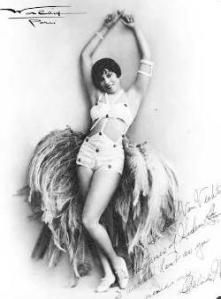 n 1936, singer Adelaide Hall‘s restless spirit encouraged her to move to Paris to live, and for the next 3-yrs, she toured extensively across Europe. Her British Sailor husband & manager, Bert Hicks, opened a Nightclub for her in Montmartre called La Grosse Pomme (the Big Apple a term claimed coined by Hicks for NYC). It became a Mecca for the rich & famous bohemians. Django Reinhardt & Stephane Grappelli, with their Quintette du Hot Club de France, were the Resident Band and Adelaide would perform Nightly at the Club. Maurice Chevalier, Marlene Dietrich and the Duke & Duchess of Windsor were regular Patrons. In Paris, she Recorded “I’m Shooting High” & “Say You’re Mine” with Willie Lewis’s Orchestra in the Spring of 1936. She also worked with Ray Ventura’s Orchestra in France. Miss Hall says she believes she and her husband coined the Big Apple as a nickname for New York City. La Grosse Pomme was the name of the Parisian Club the couple opened in 1936. ”Though it was a very tiny place, it was a big success,” the Singer recalled. ”You could cram at most 200 people in it, and everyone came -Charles Boyer, Maurice Chevalier, Mistinguett, Josephine Baker, Stephane Grappelli – I could keep going & going.” After 2 years, however, they sold their interests and moved to London, where they opened another Club, the Old Florida, which catered to the British Armed Services and which was destroyed during the Blitz. After the War, they opened a 3rd Club, the Calypso.
n 1936, singer Adelaide Hall‘s restless spirit encouraged her to move to Paris to live, and for the next 3-yrs, she toured extensively across Europe. Her British Sailor husband & manager, Bert Hicks, opened a Nightclub for her in Montmartre called La Grosse Pomme (the Big Apple a term claimed coined by Hicks for NYC). It became a Mecca for the rich & famous bohemians. Django Reinhardt & Stephane Grappelli, with their Quintette du Hot Club de France, were the Resident Band and Adelaide would perform Nightly at the Club. Maurice Chevalier, Marlene Dietrich and the Duke & Duchess of Windsor were regular Patrons. In Paris, she Recorded “I’m Shooting High” & “Say You’re Mine” with Willie Lewis’s Orchestra in the Spring of 1936. She also worked with Ray Ventura’s Orchestra in France. Miss Hall says she believes she and her husband coined the Big Apple as a nickname for New York City. La Grosse Pomme was the name of the Parisian Club the couple opened in 1936. ”Though it was a very tiny place, it was a big success,” the Singer recalled. ”You could cram at most 200 people in it, and everyone came -Charles Boyer, Maurice Chevalier, Mistinguett, Josephine Baker, Stephane Grappelli – I could keep going & going.” After 2 years, however, they sold their interests and moved to London, where they opened another Club, the Old Florida, which catered to the British Armed Services and which was destroyed during the Blitz. After the War, they opened a 3rd Club, the Calypso.
Swing Time Club – rue Fromentin
El Rodeo Club – Paris – May 1946
Playing Bop on an Electric Epiphone Guitar before the USA trip
Django Reinhardt with the Quintet renovated shines with the young but promising Michel Villers Saxophone & Clarinette.
“Le Croix du Sud” Club in Montparnasse
At the end of 1930, Grappelli was back in Paris and by 1931 was regularly engaged at the Croix du Sud, an avant-garde Bohemian Establishment frequented by, among other talents, Django Reinhardt.
Le Caveau de la Huchette is a Jazz Club in the Latin Quarter of Paris. The building dates to the 16th,C but became a Jazz Club in 1946. The design has been compared to a Cellar or Labyrinth and allegedly it was once used by Mystics & Freemasons. Since becoming a Jazz Club it has been a Venue for American greats like Lionel Hampton, Count Basie, & Art Blakey, as well as leading French Jazz Musicians like Claude Luter & Claude Bolling. Bill Coleman was an American Expatriate in France who is also associated with the Club.
Le Peit Journal 71 Bvd Saint-Michel Famous, gorgeous old Parisian Jazz Club in the heart of St. Michel
Le Bilboquet, 13 rue Saint-Benoit 6th is a Paris Jazz Institution dating back to 1947. This is a great place to soak up the unique ambience in this classy establishment. Miles, Duke & Bird all played back in the day. Situated right in the heart of Saint-Germain 50 yards from Les Deux Maggots, it is utterly authentic, beautifully decorated & lit and superb, intimate sound.
L’escadrille
It seems natural that Eugene Bullard, the runaway, the entertainer, the boxer, the decorated hero and 1st black WW1 Pilot, would learn to play music, he became a Drummer and started a Jazz Band playing at the Le Grande Duc. The years following WW1 were his best, and Eugene Bullard became the L’escadrille Jazz Club owner and was friends with people like Louis Armstrong, Roscoe “Fatty” Arbuckle, and the Prince of Wales, Edward Windsor. The Nazi Occupation and his involvement with the French Resistance meant that the Club was confiscated forcing him to leave Paris.
Le Grande Duc – (52 rue Pigalle)
A job at Le Grand Duc, a popular black nightclub, gave Langston Hughes glimpses of the haut monde who supported Montmartre’s Night Life, but more importantly, it brought him into close contact with the Black Musicians & Entertainers who gathered after hours for early morning Jam Sessions. While absorbing the richness of black culture in exile, he was amused to observe the absurdity of the American Colour Bar as exposed by the Club’s Singer, Florence Embry, who delighted in snubbing Tourists “who wanted nothing in the world so much as to have her sit down with them.” Among the many great black entertainers Hughes met at Le Grand Duc was Florence Embry’s replacement, Ada ‘Bricktop’ Smith-Ducongé, who would take advantage of the atmosphere Paris offered Blacks to rise in 10 years from a penniless unknown to “the toast of Montmartre with Dukes & Princes at her Table.” b Among the other Patrons at Le Grand Duc was Publisher and Poet Nancy Cunard.
Le Tabou was a Cellar Club located at 33 Rue Dauphine in Saint Germain des Pres, Paris. The Club opened shortly after Club des Lorientias on 11 April 1947…

At the Casino de Paris, 16 rue de Clichy, which regularly featured Jazz from late 1918 When Louis Mitchell appeared with his Jazz Kings, the Orchestra was entirely Black. The sounds of Jazz, that Black underlay, Black tumult has re-created street culture reminiscent of Harlem, strolling was not merely going out for a walk along rue Pigalle or rue Fontaine; It was more like going on an adventure. It was the feeling of adventure along the streets of Harlem but in Montmartre that attracted Sidney Bechet, who found it more to his liking than London. ” “Any time you walked down the Streets you’d run into 4/5 people you knew – Performers, Entertainers, all kinds of people who had real Talent in them …
Le Boeuf sur le Toit –
34 Rue du Colisée 75008 Paris, France – “The Nothing Doing Bar”
On 22nd January 1922 was inaugurated near the Rond-Point des Champs-Elysees, the Jazz Club “Le Boeuf sur le Toit“, which became the 1st Temple of jazz in Paris. Wiener, a young Pianist won by Jazz, plays almost every night Ragtime. Other musicians attending the Club, the pianist Arthur Rubinstein and the Composer Maurice Ravel. That’s where Ravel meets Vaucher trombonist Leo Arnaud, one of the pioneers of Jazz in France who is engaged to Hollywood in 1936 as an Orchestrator & Conductor. This is also the Club that the Guitarist Django Reinhardt attends.
Talking about the “Boeuf sur le Toit” let me remind you that this is the very place where according to Yves Salgues in “La Légende de Django” one night at 2am, Django who had just gambled and lost 100,000 Francs at the ‘Chemin de fer in a clandestine gambling-den came in. The Jo Bouillon Orchestra was playing there. His cousin Eugène Vées joined him, then his brother Joseph, and then Fouad.- “Champagne, Monsieur Moïses” said Django with a tired voice. The Musicians of the Orchestra are packing up their belongings. On the stage lies a Guitar. Django looks at it for a moment, he stands up, takes it and rests it on his knees and starts ringing a few notes. Does he realise at this moment that he is improvising something eternal just as imperishable as Handy’s ‘St Louis Blues’ or Gershwin’s ‘The Man I Love’? That night, at the “Boeuf sur le Toit” was born ‘Nuages‘…He will receive in less than 3 years, 780,000 Francs in Royalties for this sole Title [15M of 1957 French Francs]. Some Lyrics will be added to this tune and it will be played even in the smallest French Village Dance.
The Boeuf sur le Toit was 1st Established in 1922 by Louis Moysès, and originally it was located on Rue Boissy d’Anglas, but then moved to Rue de Penthievre and then in 1941 it moved again to its present location which is on the Rue du Colisee. In this case, ‘Boeuf’ is nothing to do with Beef, but actually French slang for a Jam Session, and there are still frequent Jazz Concerts at the Restaurant once a favourite of Jean Cocteau. Louis Moysès (the owner of the Cabaret, who used to serve Champagne to Django)
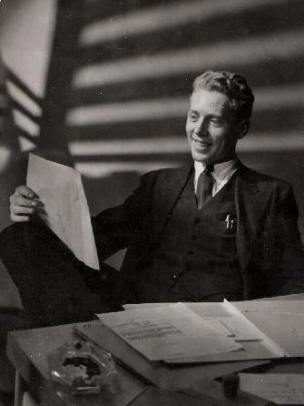 In 1943, at the age of 20, Bernard Peiffer made his professional debut with Alto Saxophonist Andre Ekyan. Soon after, he was hired by Django Reinhardt to play with a 10-piece band at Boeuf Sur Le Toit in Paris. Bernard credited Reinhardt with teaching him the music business, and Django predicted a brilliant career for Peiffer. Their musical association and friendship continued through the years; Django, not known for his fondness of working with Pianists, would often show up nightly to Bernard’s Engagements to “sit in.”
In 1943, at the age of 20, Bernard Peiffer made his professional debut with Alto Saxophonist Andre Ekyan. Soon after, he was hired by Django Reinhardt to play with a 10-piece band at Boeuf Sur Le Toit in Paris. Bernard credited Reinhardt with teaching him the music business, and Django predicted a brilliant career for Peiffer. Their musical association and friendship continued through the years; Django, not known for his fondness of working with Pianists, would often show up nightly to Bernard’s Engagements to “sit in.”
Django Reinhardt’s previous plans to visit America were cut short by the War. He was finally able to cross the Atlantic in late 1946 and appeared with Duke Ellington, whom he knew from Jam Sessions in pre-War France. For various reasons, Django’s Trip to the State’s did not turn out to be the great success he and his managers had expected. Somewhat disillusioned, Reinhardt returned to France in February 1947 and shortly after began a renewed residency at the “Boeuf sur le toit” in Paris.
Although Django’s playing had by now become a notch more modern, the old magic between the 2 main figures of the pre-War Quintet is still evident. In April, Reinhardt recorded with the Band that worked with him at the “Boeuf sur le toit” in Paris. After this residency came to an end, the Guitarist accepted an offer to Tour Belgium, for which he reassembled his 1941 Quintet with Clarinettist Hubert Rostaing. “Babik (Be-Bop)” from May 1947 proves that Django and his men were well aware of the new trends in Jazz, while also still turning in the kind of music Django has played & recorded before the War. After this Session for Decca during which he also used the Electric Guitar for the 1st time, the reshuffled Quintet was recorded by the Blue Star Label recently founded by Nicole & Eddie Barclay, The unusual ‘Danse Norvegienne” is followed by a particularly inspired “Blues For Barclay“.
Django tuning up at the Boeuf
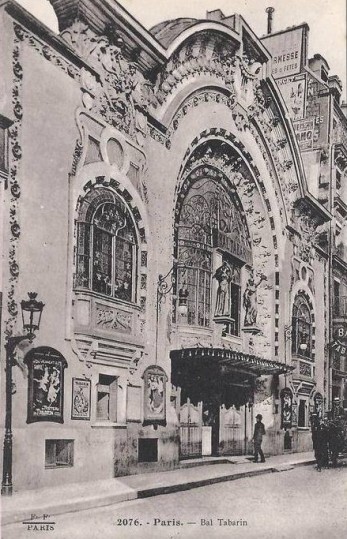 Le Bal Tabarin Cabaret 1944
Le Bal Tabarin Cabaret 1944
This is a good quality Video copy. It shows “Django Reinhardt et son Orchestra” at Bal Tabarin, 58 Rue Pigalle in 1944. Django appears just after the sequence showing Marlene Dietrich at 1.50.
The speed of his fingers and his vibrato are amazing. At the start of the clip, Gerard Leveque & Joseph Reinhardt can be seen in the background on Stage. The background Music does not appear on record anywhere and was almost certainly recorded at the gig.
The tunes are “Night & Day“, “Shorty George” and the opening sequence to “I Can’t Give You Anything But Love”. The voice that can be heard on a couple of occasions sounds very much like Charles Delaunay.
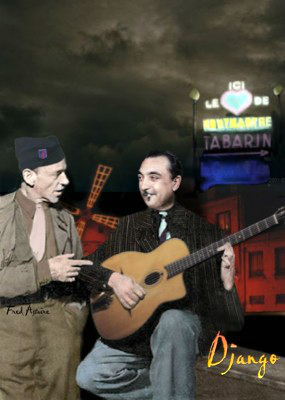
Rue Pigalle 1939
La Roulotte – Name of Django’s own Night Club – later “Chez Django Reinhardt“
Club Saint Germain 13, rue Saint Benedict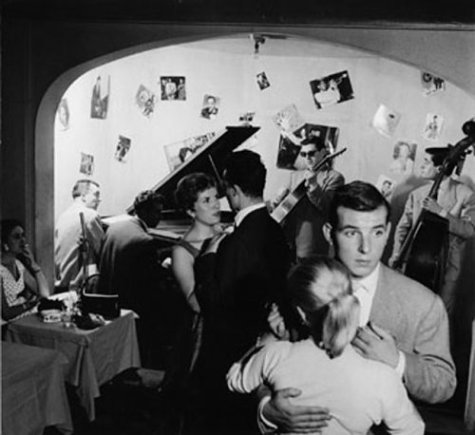
This was one of the Jazz Clubs of Paris’s most famous. Opened 11th June 1947, animated 1st by Boris Vian and the former Team of Tabou, including Juliette Greco. In the late ’40s and for 3-yrs, the Orchestra is directed by Jean-Claude Fohrenbach. It included: Guy Longnon (trumpet), Benny Vasseur (Tb), Claude Bearing (alto saxophone), Maurice Vander & Raymond Fol (piano), Alf and Barry Masselier Spiel (former Bassist Benny Goodman) and Robert Barnett (drums). We can applaud Django Reinhardt, Martial Solal, Barney Wilen … but also many Americans visiting the Capital: Lester Young, Kenny Clarke, Miles Davis …
1947-49: Boris Vian leads the small set of Club Saint Germain. Jean-Claude & Hubert Fol
1948: At the end of the year: Afternoon: Claude Bolling & his Orchestra.
1949-50: Boris Vian & his Orchestra.
Jean-Claude Fohrenbach and his new training with Roy Eldridge current 1950.
Tadd Dameron gave Cab Kaye UK Singer his 1st and only Piano Lesson. In the Club St Germain Cab Kaye played with Guitarist Django Reinhardt who had become more interested in Bebop
The Benedictine Abbey of Saint-Germain-des-Prés, just beyond the outskirts of early Medieval Paris, was the burial place of Merovingian Kings of Neustria. At that time, the Left Bank of Paris was prone to flooding from the Seine, so much of the land could not be built upon and the Abbey stood in the middle of Fields, or prés in French, thereby explaining its appellation. The Abbey Church remains as the Église de Saint-Germain-des-Prés, Paris. The German occupation, paradoxically, is a rich moment for the life in St Germain. Indeed, the German didn’t like much this part of Paris and avoided it. Its wasn’t her greatest pride, the quasi-absence of German Soldiers during the Occupation, when the Huns paraded fiercely on the Grands Boulevards, Opera, Champs Elysees. The intellectual & literary aura & prestige of St Germain was sufficient to put them in discomfort!. An anecdote from the guide du Routard, (quote): “In the winter Simone de Beauvoir came always 1st thing in the morning to the “Flore” to have a seat near the Stove. It was so bitter cold elsewhere! Sartre recreated the atmosphere of an English Club. Everybody listened to Jazz, read poems or played little Acts.”
Pianist Eddie Barclay hosts during the occupation clandestine parties in a Cellar in the rue Saint-Benoît Saint-Germain-des-Pres, where youth ‘Zazou‘ just listen to American Jazz playing with friends of his Jazz Band: Django Reinhardt, Boris Vian, Henri Salvador & Moustache. Eddie Barclay appears 18th October 1942 at the Festival de Jazz de Bordeaux.
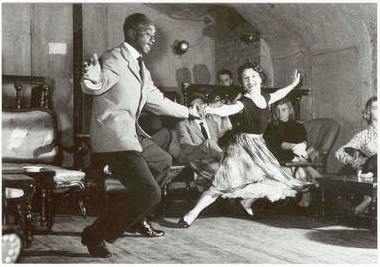
Dans un Club de St Germain-des-Pres. Paris 1956
It’s after the liberation that Saint-Germain became world-known with its Nightlife, its Cave Nightclubs, avant-garde Music, Jazz, and women in black pants and with long hair. The most representative of that period are Sidney Bechet, Claude Luter, Boris Vian & Juliette Greco (under the benevolent eye of Sartre, Simone de Beauvoir & Albert Camus, meeting in “Le Tabou” (Rue Dauphine), in the Club of the “Vieux Colombier”. American Be-bop is the absolute trend. The area was one of the most animated in Paris! Even if the memory of that period is a long time gone, something still remains. Don’t forget, on the Place Saint-Germain, the Deux Magots is still there, even if it’s become the most expensive coffee or any drink in Paris.
At night in the famous Cellars, such as “Le Bar Vert” or ” Le Tabou” that caused such a scandal. In these Cellars, Artists listen to the New Orleans Jazz and Be-Bop, brought to the Club Saint Germain or to the Blue Note by Sidney Bechet, Miles Davis & Duke Ellington. Juliette Gréco & Anne- Marie Cazalis are the Queens of those nights and launch the existentialist stream.
Lionel Hampton Club now Jazz Club Etoile

QHCF – Chez Bricktop Paris 1947
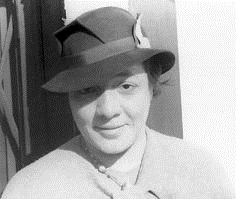 Chez Bricktop
Chez Bricktop
Born Ada Beatrice Queen Victoria Louise Virginia Smith in 1890s West Virginia, she moved with her family when she was still a child to Chicago where, at a very tender age, she was caught up in the Saloon life of the City. It was there that she acquired the nickname Bricktop for her flaming red hair & freckles. By the time she was 16, she was a Touring Vaudevillean and in her early 20s in New York City, she’d already changed the future of American Entertainment by getting the young Duke Ellington one of this 1st Gigs.
Chez Bricktop – where her headliner was Mabel Mercer. The celebrities of the day flocked to her Club, including the Duke & Duchess of Windsor, F. Scott Fitzgerald, Hemingway, Tallulah Bankhead & of course, Cole Porter himself. Langston Hughes, of all people, was a Busboy (or a Dishwasher, depending on what you read) in her Club. Josephine Baker was one of her Protegés, and the 2 women enjoyed a Lesbian affair for a time.
Langston Hughes’ thumbnail from his autobiography is direct & enduring:
“Bricktop sang in a cute little voice, with nice, wistful notes. She danced a few cute little steps, tossed her head & smiled, and went around to all the Tables and was pleasant to everybody – from Guests who could afford only one Quart of Champagne to those who bought 12 Bottles. French, or American, Tourist or Diplomat, white or coloured, were all the same to Brick. Her Professional manner was simply her own manner, in the Club or out.”
When [Ada] Bricktop [Smith] arrived in Paris on 11th May 1924, it took her only 2 Nights” to see just about every American Negro, “she Stated:” Opal Cooper, Sammy & Harvey White, Charlie ‘Dixie’ Lewis, Bobby Jones and maybe 10 other Negro Musicians were the only Negro men in Paris. “and all of them were in Montmartre. By 1925, Paris had its own version of the Harlem Renaissance. The Black uproar was the “noise” in Montmartre stirred up by the stream of Black Musicians & Entertainers coming from America and finding steady Race-blind Employment in France. “All the Nightclubs in the area of Pigalle,” Bricktop recalled, “had at least a few Blacks In their Orchestra.”
- Abbey of Thelema: 1 Place Pigalle, 1924-1934.
- Apollo: 20, rue de Clichy: 1919-1955.
- La Bagatelle: 20, rue de Clichy: 1937-1946
- Bricktop’s Big Apple: 66 ou 73, rue Pigalle ; 1926-1936 (led by Singer Ada “Bricktop” Smith)
- Bricktop’s Chez Fricker: 73, rue Pigalle ; 1937-1938 (led by Singer Ada “Bricktop” Smith).
- Casino de Paris: 16, rue de Clichy ; 1914-1952.
- Le Chantilly: 10, rue Fontaine: 1934-1947.
- Chez Florence (ou Le Florence: 61, rue Blanche ; 1925-1952.
- Chez Mitchell (ou Mitchell Pan Cake): rue Pigalle; c.1925 (Led by drummer Louis Mitchell became Music Box)
Louis Mitchell was a drummer from Harlem. After returning home, Mitchell tried to assemble an Orchestra to play at the Casino de Paris, but the State Department’s post-War restrictions on issuing Passports to persons or non-vital importance for travel to France forced him to cancel the project. With dogged persistence, Mitchell got together a 7-man Project and left for France. He settled with his wife and son in the heart of Montmartre, at 69 Rue de Clichy, a Street that would soon be dotted with small Nightclubs featuring Black Jazz. The Mitchells opened their home to the growing expatriate Community of Black American Civilians and former Soldiers who remained in France after discharge and extended the welcome mat to Musicians fresh from home anxious for advice on “how to do it“ in Paris; they became an early symbol of “Jazz as the Family“ in Montmartre. - Coliseum: 65, rue Rochechouart ; 1929-1952.
- Côte d’azur: place Blanche; 1933-1934.
- La Florida: 20, rue de Clichy; 1928-1929.
- Le Grand écart : 7, rue Fromentin; 1929-1934. The Splits:
- Le Montmartre: 20, rue de Clichy; 1932-1934.
- Le Moulin Rouge: 82, bd de Clichy, place Blanche; 1926-1960.
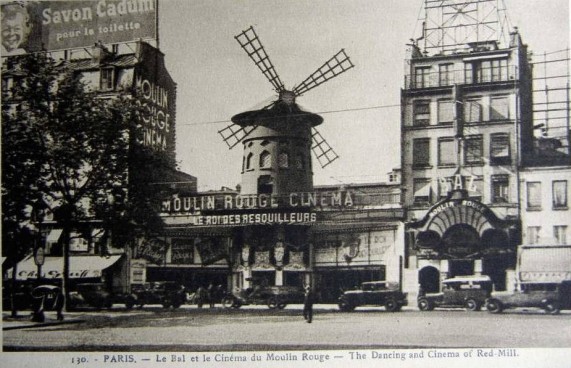
- Music Box: rue Pigalle ; 1925-1935.
- Les Nuits Bleues: 7, rue Fromentin: 1935. The Blue Nights:
- Le Perroquet : 16, rue de Clichy: 1917-1930. The Parrot:
- Swingtime (Chez André Ekyan): 7, rue Fromentin ; 1936-1937.
- Le Tabarin: 34-36, rue Victor Massé ; 1930-1950 51.
- Théâtre Pigalle: 10, rue Pigalle ; 1929-1950.
- Zellis: 16 bis, rue Fontaine ; 1922-1932.
- Le Grand Duc: angle de la rue Pigalle et de la rue Fontaine (source: Martin – Roueff 2002)
Louis Mitchell went on to win the French Capital. At a Craps Game, he gained quite a large sum that allowed him to regain the Grand Duke whose inauguration was madness. Revellers we saw scroll necked dress and ladies covered with jewels. It is interesting to note the opposition detail: in New Orleans and even in Chicago during that period, Jazz was reserved for the most popular elements of the Public; in Paris, he became an aristocratic triumph.
